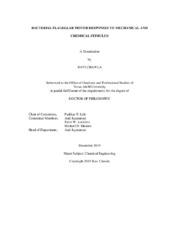| dc.description.abstract | Recent work has shown that the bacterial flagellar motor is able to regulate its structure in order to adapt to long-lived perturbations in the cell’s thermal, chemical, electrical, and mechanical environments. These flagellar adaptations play a key role in invasion, colonization, and pathogenesis. However, the mechanisms of adaptations are unknown. Here, we determined the mechanisms of motor adaptation to mechanical and chemical stimuli with the overall goal of explaining how the motor regulates cell physiology. The flagellar motor consists of a membrane-embedded stator and a transmembrane rotor. We determined the mechanisms whereby the flagellar stator-complex senses mechanical signals and remodels in response. The remodeling involves recruitment of additional stator-units to the original complex as the viscous load increases. Our experiments suggested that the association of stator units to the motor was strengthened when the torque they delivered to the rotor increased. An analytical model that incorporated an exponential decay of the stator unit’s dissociation rate with increasing torque provided accurate fits to the experimental measurements of stator-rotor binding over a wide range of loads. When mechanical resistance to motor rotation increases, the torque delivered by each unit also increases. This leads to remodeling under increased viscous loads.
Next, we utilized flagellar motor output as a probe for the chemotactic responses of E. coli to a prominent gut microbiota metabolite, indole. Indole regulates numerous bacterial phenotypes, however, its role in the modulation of bacterial chemotaxis is poorly understood. We discovered that E. coli exhibited a time-dependent inversion in response to indole; a strong repellent response inverted to a potent attractant response above a threshold concentration of indole. The opposing responses were mediated by two major chemoreceptors. Interestingly, the flagellar motor itself mediated a repellent response independent of the receptors. Our chemotaxis assays revealed the broad implications of this inversion –wild-type cells were attracted to regions of high indole concentrations only if they had adapted to it previously. Otherwise, they were repelled. We propose that indole likely segregates beneficial and harmful bacteria based on their state of adaptation to promote the development of healthy niches in the GI tract. | en |


